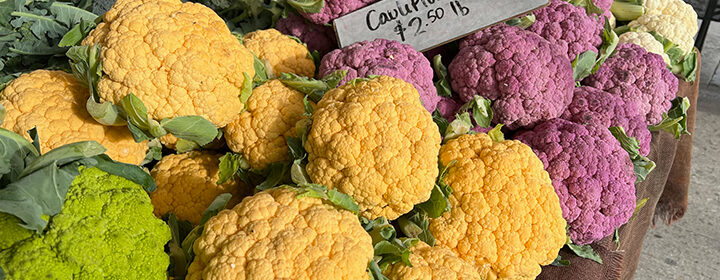How to Grow Cauliflower

As you’ll soon see, I can’t grow cauliflower due to our very hot and dry summers. But this tasty crop grows well in so many regions!
Latin Name: Brassica oleracea var. botrytis
Plant Family: Brassica (Brassicaceae)
Cool-season crop
Did You Know?
The earliest documented records of cauliflower cultivation date back to the 6th century B.C. Three-quarters of the world’s cauliflower crops are produced by China and India. Cauliflower heads consist of tiny immature flowers. There are now cultivars that feature white, purple, orange and yellow heads. That makes it more fun to grow cauliflower!
Plant Seeds or Seedlings? Start seeds indoors or purchase seedlings at a nursery.
When: Start seeds 4 to 6 weeks prior to transplanting.
Days to Germination: 8 to 10 days
Depth to Sow: 1/2 inch
Spacing: 18 to 24 inches
Days to Maturity: 60 to 80
Cultural Information:
Prepare bed. Be sure to follow the recommended spacing for seedlings at transplanting time. Why is this important? The plants require a lot of room to grow and will not produce satisfactory heads if they are crowded. If aphids or cabbage worms are a problem in your area, I have an easy solution for you. Immediately cover the bed with floating row cover or agricultural insect netting to create a physical barrier over the plants. Cauliflower does not require pollination so the cover can be left in place for the entire season.
This crop does not tolerate high temperatures. How do I know this? I’ve never gotten it to grow here in Spokane, Wash. where we have hot, dry summers. If necessary, cover them with shade cloth during the heat of summer. Keep soil moist but not sopping wet. For white-headed varieties, you can “blanch” the heads by tying the leaves together over them when they start to form. That will protect the heads from the sun’s rays.
Susan’s Picks: ‘Cheddar’ and ‘Flamestar’ (orange), ‘Vitaverde’ (green), ‘Graffiti’ and ‘Purple of Sicily’ (purple), ‘Snow Crown’ and ‘Amazing’ (white)
Potential Insect Problems: Aphids, cabbage worms, slugs, pillbugs
When to Harvest:
Pick cauliflower while the heads are tight. Once the florets begin to separate, the eating quality deteriorates.
How to Cook & Preserve:
Enjoy fresh florets as an appetizer or steam for a side dish. Another great option is to roast cauliflower and garlic together for a winning combination. To preserve cauliflower for later use, blanch florets in boiling water for three minutes. Then plunge into ice-cold water, drain and pack into freezer bags.
My Videos About Growing Cauliflower:
- Organic Insect Control: Aphids, Cabbage Worms & Leafminers
- Grow Cabbage Family Crops
- Organic Insect Control: Flea Beetles, Hornworms, Slugs & Snails
Back to Vegetable Grow Guide Chart
Copyright: Susan Mulvihill, Susan’s in the Garden, SusansintheGarden.com

